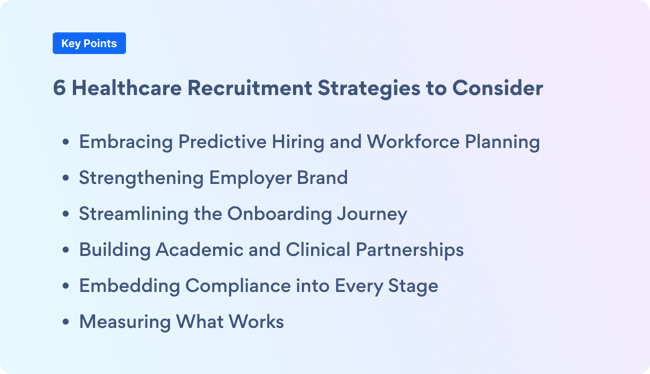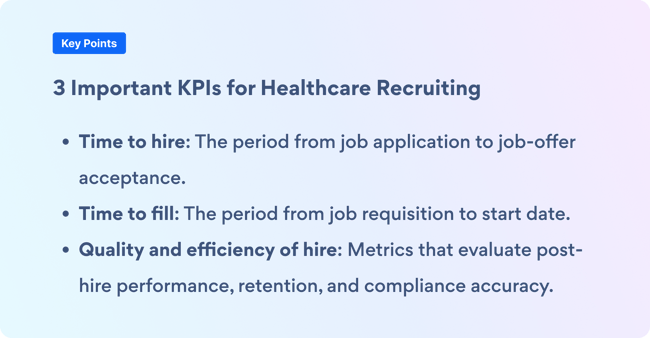

Between finding the right candidates and navigating complex regulations, hiring in the healthcare...

The healthcare workforce remains under extraordinary pressure. Despite sustained hiring momentum, most health systems still struggle to attract and retain qualified talent. That’s not the only challenge—from credentialing delays of 90 to 120 days to rising burnout and turnover, every inefficiency compounds the gap between patient need and staff availability.
In this environment, successful healthcare recruitment strategies must balance key priorities—filling roles faster, maintaining compliance, and protecting patient safety. This article explores the most effective healthcare recruiting strategies for organizations that want to build resilient workforces, streamline hiring, and reduce risk through trusted screening and credentialing processes.
Key TakeawaysHere’s what every healthcare HR and talent acquisition leader should know in 2025:
|
Persistent workforce shortages and evolving regulatory demands continue to shape healthcare staffing strategies across the industry.
According to the Bureau of Labor Statistics, the U.S. healthcare industry added about 55,000 jobs in July 2025, above its 12-month average of 42,000. But even with steady job growth, vacancies remain high.
The NSI 2025 National Healthcare Retention Report shows registered nurse turnover of 16.4%, with some specialties above 20%. The 2025 Survey of Registered Nurses by AMN Healthcare finds 58% of nurses reported feeling burned out, and 61% plan to make some kind of change to their department, employer, or career in the next 12 months.
Meanwhile, critical health workers, nurse assistants, and primary care physicians are among other healthcare fields facing shortages, according to the American Health Association.
Credentialing delays compound the issue: Most organizations still report 90 to 120 days from application to start date, which limits flexibility and inflates labor costs.
What’s driving today’s talent crunch? Here are three key factors—and how to start addressing them.
Compensation isn’t the only factor driving healthcare turnover. Healthcare professionals also cite administrative overload, inadequate support, and limited flexibility as reasons for leaving direct care.
Retention strategies now emphasize scheduling autonomy, workload balance, work-life balance, and culture. These areas align with workforce engagement and long-term stability.
For most healthcare organizations, each stage of provider onboarding still depends on fragmented systems and manual reviews. Verification data moves slowly between HR, compliance, and payer networks, creating bottlenecks that delay time to start.
Centralizing these workflows with automation and accountability structures can reduce rework and accelerate the hiring process.
Expanded use of telehealth and contract labor has multiplied the number of licenses, background checks, and credential updates organizations must maintain. Each state’s requirements vary, increasing administrative burden and audit exposure.
Integrated compliance tools that consolidate verifications and continuous monitoring are now essential components of modern recruiting infrastructure.
Many of these strategies reflect the broader workforce and technology shifts shaping healthcare recruitment and compliance practices across the industry.
A disjointed onboarding process doesn’t just delay hiring—it creates a ripple effect that affects revenue, retention, and care quality simultaneously.
Every extra week in the credentialing queue forces existing healthcare workers to stretch further, which contributes to overtime fatigue and higher error rates. Meanwhile, compliance teams scramble to keep files current, which risks missed verifications or lapsed licenses.
When onboarding isn’t built for scale, small inefficiencies multiply. The result is a cycle of short-staffing, reactive hiring, and turnover that feels impossible to break.
The first few weeks of employment shape how long new clinicians stay. Yet in many organizations, onboarding still means hours of repetitive data entry, incomplete orientation, and poor communication between HR and department leaders. For frontline staff, that chaos becomes their first impression of your culture.
A more deliberate onboarding approach will align clinical training, digital credential access, and administrative setup from day one—reducing frustration and preventing early disengagement. The difference isn’t theoretical: Hospitals that streamline onboarding have measurable gains in first-year retention and patient satisfaction.
Credentialing is often viewed as a compliance task instead of a strategic priority—and that’s where the damage happens. When HR, compliance, and medical staff offices operate in silos, applications get stuck in various approval stages. Those bottlenecks waste time, reduce patient capacity, and result in lower billing volume.
Organizations that collapse these silos into a single workflow cut onboarding delays significantly. The Cisive provider onboarding framework demonstrates how aligned verification processes and automated alerts can eliminate redundancy while maintaining accuracy.
Onboarding delays create more severe effects at rural healthcare organizations. A single vacant provider position in a critical access hospital can mean reduced clinic hours or a temporary closure. Recruiting from outside regions is difficult when onboarding takes months, as candidates must relocate or navigate multiple state licensing requirements.
Consolidated credentialing databases and digital verification tools help rural systems bring clinicians on board faster, preserving revenue and continuity of care.
Compliance failures rarely stem from bad intent, but rather from bad infrastructure. When background checks, drug testing, immunization tracking, and license monitoring all run on different systems, information gaps appear. Those gaps expose organizations to fines, payer sanctions, and reputational risk.
Integrating these checks into a unified background check compliance process gives compliance leaders real-time visibility. A unified compliance process frees HR from manual follow-up and reduces delays that keep new hires from seeing patients.

Hiring in healthcare isn’t one process. Rather, it’s a collection of systems that must move in rhythm. The following healthcare recruiting strategies show where alignment matters most—and how to create stability through your hiring processes.
Hospitals that wait for vacancies are already behind. Predictive workforce modeling gives recruiters visibility months ahead of demand spikes, helping them shape candidate pipelines before shortages hit.
Health systems using workforce analytics to forecast turnover and patient volume are reducing contract labor costs by shifting to internal float coverage and hiring in advance of demand.
Technology matters, but so does having recruiters who understand how AI surfaces patterns and can use those insights to make better decisions, faster. Effective AI in healthcare recruiting sees analytics and human insight work side by side to forecast talent needs.
Some hospitals focus on “marketing the role.” The ones that succeed market the experience. Candidates are asking: What does support look like on a hard day? How much autonomy do I have? How long before I burn out? Your answers will define your brand more than any campaign.
To attract and retain talent, you need a clear, consistent message about professional growth and patient safety. The organizations getting it right aren’t shouting about their culture—they’re demonstrating it through strong employer branding, transparent communication, realistic job previews, and leadership accessibility.
No one joins a hospital hoping to spend their first month chasing documents. Yet that’s still the norm in many systems. The result is predictable: early frustration and preventable attrition.
Health systems that move from email-based credentialing to centralized onboarding platforms report significant gains in speed and retention.
A detailed provider onboarding framework shows how similar integrations align HR, compliance, and clinical leadership to eliminate redundant reviews.
This is the quiet, long-term play. Partnering with nursing schools and allied-health programs creates a direct pipeline of pre-screened graduates who already understand your organization’s culture and systems. Early engagement means credentialing and background checks can begin before graduation, further shortening the post-hire ramp-up period.
Student background checks let institutions verify readiness for clinical rotations and permanent roles, protecting students and patients. When these partnerships work, the line between “recruitment” and “education” almost disappears.
Compliance isn’t a box to tick; it’s the backbone of trust. Yet in many systems, it’s treated as a handoff between departments. Bringing it forward into the first recruiter call and the first interview will build credibility and save time later.
Below are the components most organizations are consolidating into continuous workflows:
Drug and occupational health testing for pre-employment and return-to-work screening
Healthcare license monitoring with automated renewal alerts
Exclusion and sanction screening to prevent regulatory violations
Immunization tracking for workforce safety and compliance audits
Automating these steps saves time for recruiters while offering real-time compliance oversight. You gain speed without taking shortcuts.
Metrics don’t solve problems, but they can reveal where to start. Leading systems are connecting hiring data to clinical outcomes—tracking not just time to hire but also time to readiness, credentialing accuracy, and first-year retention.
By integrating recruitment and compliance metrics into enterprise risk dashboards, recruiting and HR teams can provide leadership with a single source of truth. Insights generated through healthcare risk management software translate HR performance into measurable operational stability—a language the C-suite understands.

Assessing hiring performance depends on two things: how efficiently candidates move through the process and how well new hires perform. The metrics that matter most connect speed with quality—giving healthcare organizations a clear view of where their processes succeed or stall.
Key performance indicators (KPIs) to track in your healthcare recruitment strategy include:
Time to hire: Measuring the span from application to acceptance reveals how effectively teams manage the recruiting and credentialing process. A shorter time to hire indicates smoother coordination between HR, compliance, and medical staff offices.
Time to fill: Calculating time to fill—from job requisition to start date—uncovers bottlenecks that delay onboarding and inflate costs. Understanding requisition bottlenecks can help you target improvements with the highest operational impact.
Quality and efficiency of hire: Evaluating post-hire performance, retention, and compliance accuracy shows whether recruiting practices are delivering the right talent, not just faster results. Organizations that use clear benchmarks for effective hiring practices can align KPIs with broader workforce goals and make measurable progress toward long-term stability.
Tracking these indicators turns hiring from a reactive process into a strategic function—improving care delivery, controlling labor costs, and strengthening compliance at every stage.
Hiring in healthcare is uniquely complex. Every role—from physicians to administrative staff—carries regulatory and safety obligations that go beyond standard recruiting. Comprehensive background check services help organizations manage that complexity with structure and consistency. When verification, credentialing, and compliance checks are centralized, teams can move faster, reduce administrative load, and minimize risk across the entire workforce.
Reliable screening programs also strengthen efficiency at the organizational level. Automated license verification, exclusion monitoring, and health-status tracking shorten credentialing timelines, ensuring that only qualified staff are operating in patient care settings. Fewer manual reviews mean fewer bottlenecks, allowing HR, compliance, and medical staff teams to focus on strategic priorities instead of paperwork.
The most effective healthcare recruitment strategies require every step—from recruitment to onboarding—to be backed by dependable verification. PreCheck connects those steps. The platform integrates background screening, credentialing, and compliance oversight into a single, transparent process that keeps hiring teams informed and candidates moving. That visibility shortens onboarding cycles, reduces compliance workload, and ensures qualified clinicians are ready to deliver care when they’re needed most.
By combining automation with decades of healthcare expertise, PreCheck helps organizations hire faster without compromising accuracy or safety. Every verification, license check, and compliance review feeds into a continuous system of accountability that strengthens patient trust and workforce stability. To see how this approach can align with your organization’s goals, speak with a PreCheck expert.
Healthcare employers face simultaneous pressures: persistent talent shortages, an aging workforce, and increasingly complex regulatory demands. Beyond the clinical gap, administrative and compliance roles are also difficult to fill. Healthcare organizations finding success are those investing in workforce analytics, standardized credentialing, and a stronger employee value proposition that speaks to flexibility, well-being, and long-term professional growth.
Speed and accuracy don’t have to conflict. Effective healthcare recruiting strategies reduce time to hire by consolidating recruiting, credentialing, and compliance systems into a continuous workflow. Automated verification, digital documentation, and real-time data sharing eliminate redundant handoffs that used to take weeks.
By embedding screening technology early in the process, HR and compliance teams maintain regulatory rigor while moving qualified candidates into roles faster—without compromising patient safety or quality standards.
Most healthcare employers report a credentialing timeline of roughly 90 to 120 days, but that range is shrinking as automation becomes more common. Digital verification platforms reduce manual outreach and accelerate payer approvals, cutting onboarding time by as much as 25% in large systems.
The real opportunity lies in consistency. When credentialing operations are centralized and have standardized data inputs, there’s less variance. Organizations possess audit-ready records. Staff can focus on high-value review rather than paperwork.
Workforce trust starts with thorough background screening that verifies clinical qualifications, flags regulatory sanctions, and confirms that every hire meets internal and federal compliance standards. Comprehensive screening also supports quality of care by ensuring potential hires are both licensed and fully vetted. When integrated with continuous monitoring and credential management, background checks evolve from a one-time safeguard into an ongoing system that protects patients and the organization.

Between finding the right candidates and navigating complex regulations, hiring in the healthcare...

Eighty-one percent of healthcare executives say that talent shortages will significantly impact...

Hiring in healthcare carries a higher standard of responsibility than almost any other field. When...